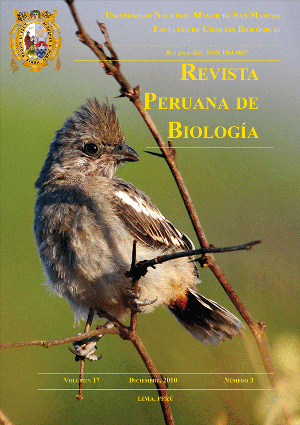Prevalence and distribution of the principal etiologic agents that affecting wild shrimps from Tumbes, Peru
DOI:
https://doi.org/10.15381/rpb.v17i3.11Keywords:
Prevalence, WSV, IHHNV, BP, shrimp diseases.Abstract
Prevalence and distribution of different pathogens of wild shrimp in the tidal channels of the Region Tumbes - Peru, during March to December 2009. The tidal channels considered in this study were: Boca del Rio Tumbes, El Alcalde, Jelí, El Bendito, Envidia, Soledad and Algarrobo. We collected a total of 1926 shrimps between juvenile and pre-adults of the species Litopenaeus vannamei, L. stylirostris y Farfantepenaeus californiensis. Using the PCR technique, detected the presence of pathogens NHPB (0.62%), IHHNV (0.31%), BP (1.61%) and WSV (2.75%); no infection was found by TSV. The three species studied were positive for WSV and BP showed the highest prevalence of WSV infection (2.98%) in the species L. stylirostris and BP (2.66%) in L. vannamei. The NHPB was detected in the species L. vannamei, L. stylirostris to 0.77% and 0.43% prevalence respectively. There was a prevalence of 0.52% for IHHNV in L. vannamei. The highest prevalence of infec- tions WSV, BP, NHPB and IHHNV were recorded in the tidal channels El Alcalde (10.79%), Algarrobo (4.51%), Envidia (2.26%) and Jelí (5.05%) respectively. Data showed that the constant presence of various pathogens in different penaeid species and their wide distribution along the coast Tumbes, which could produce an impact on wild stocks of shrimp and being a potential risk for development of aquaculture in the region.Downloads
Downloads
Published
Issue
Section
License
Copyright (c) 2010 Rubén Alfaro Aguilera, Mervin Guevara Torres, Isaías Gonzales Chávez

This work is licensed under a Creative Commons Attribution-NonCommercial-ShareAlike 4.0 International License.
AUTHORS RETAIN THEIR RIGHTS:
a. Authors retain their trade mark rights and patent, and also on any process or procedure described in the article.
b. Authors retain their right to share, copy, distribute, perform and publicly communicate their article (eg, to place their article in an institutional repository or publish it in a book), with an acknowledgment of its initial publication in the Revista Peruana de Biologia.
c. Authors retain theirs right to make a subsequent publication of their work, to use the article or any part thereof (eg a compilation of his papers, lecture notes, thesis, or a book), always indicating its initial publication in the Revista Peruana de Biologia (the originator of the work, journal, volume, number and date).






